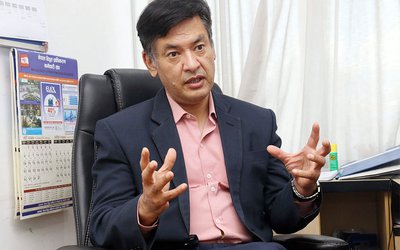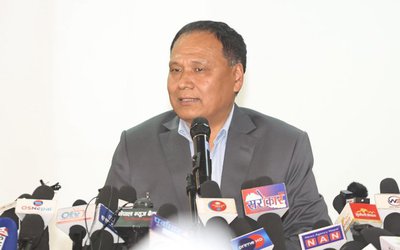
Nepal's economy is projected to expand by 3.3% in FY24, primarily due to the resurgence of tourism and an uptick in hydropower exports. Private consumption is expected to be the main driver of growth, fueled by a significant rise in remittance inflows.
The World Bank's biannual country development update highlights these trends. Finance Minister Barshaman Pun, who has been in office for 18 months, is striving to implement more flexible policies to support economic recovery. Minister Pun emphasized the importance of collaboration to stimulate the economy and assured that the government will implement necessary measures to create a conducive environment for the private sector.

Despite the challenges faced by Nepal's economy, there are some positive developments such as improvements in the balance of payments, a notable increase in remittances by 21%, and a rise in foreign exchange reserves by 21.7%.
However, the country still grapples with a significant trade deficit and relies heavily on imports, particularly for essential goods like agricultural products. While there are positive signs emerging and The World Bank's report provides some optimism, Finance Minister Pun and Central Bank Governor Maha Prasad Adhikari may find solace in these encouraging indicators.
The positive signs of remittance-based on the external front are overshadowed by the unchecked deterioration in our trade position. The last fiscal year (FY2079\80) was the worst in recent times, and unfortunately, the current FY 2080\81 does not show signs of improvement. It is worth noting that both export and import have decreased in the first eight months of this FY compared to the same period last FY - export declined by 4 percent and import by 2.7 percent.

The decline in import is attributed to the ban on the import of certain items by the Nepal government. Additionally, the significant decrease (42 percent) in official rice import during the first 8 months of this FY, mainly due to restrictions imposed by India on its export, may also be a contributing factor. Despite the apparent decline in rice import, illegal imports have helped maintain a stable supply and prices in the market after the Indian restrictions were imposed.
The recent rise in rice production in Nepal, from 54 lakh 86 thousand tons to 57 lakh 24 thousand tons, may have played a role. When it comes to boosting exports, increasing the production of exportable goods that can replace imports seems to be the only viable solution. However, it is challenging to expect producers to ramp up production when farmers are forced to discard their produce due to a lack of market access.
Dairy farmers are lodging complaints against dairies, including the government-owned DDC, for delayed payments for milk purchases. Even budgetary incentives tied to production fail to yield the desired results in such circumstances. Additionally, export commodities like tea, which have been performing well in recent years, are encountering various non-tariff barriers when it comes to exporting to India.
Meanwhile, data indicates a decline in both the acreage and production of Chaitra dhan (off-season paddy) over a three-year period, with production dropping from 561 thousand tons in FY 2078\79 to 520 thousand tons in FY 2080\81, and the cropped area decreasing by 16 thousand hectares during the same period.
Nepal's economy is currently facing a variety of challenges, particularly in relation to debt servicing. The government's inability to meet revenue collection targets has brought significant attention to this issue. It has been estimated that the government will require around Rs. 500 billion to service its debt, leading to a heavy reliance on borrowing, both domestically and internationally. In the first eight months of this fiscal year, Rs. 126 billion has already been paid towards debt servicing. During this period, the total public debt has reached Rs. 2388 billion, with Rs. 1202 billion coming from external loans and Rs. 1185 billion from internal loans.
Only 45 percent of the targeted revenue (Rs. 1422 billion) was collected in the same period, indicating a lackluster performance. It is highly likely that the authorities will need to borrow the entire targeted internal sum of Rs. 240 billion. The external borrowing target of Rs. 212 billion remains uncertain, as it is dependent on the performance of capital expenditure. Dr. Tilak Rawal, former governor, highlights the concern that new borrowing is being used to pay off previous debts and cover unproductive expenses, emphasizing the importance of utilizing borrowed funds for productive purposes.
The report indicated that the accommodation and food services sector took the lead, driven by a notable surge in tourist arrivals. Additionally, financial and insurance activities experienced growth, while wholesale and retail trade saw a decline.

The industrial sector also played a role in the economic expansion, with increased hydroelectric production providing support. Agriculture witnessed a rise in paddy production, thanks to better seed availability and favorable weather conditions.
Given the unstable and unpredictable nature of the government, ensuring stable policies and programs, predicting Nepal's long-term economic recovery remains challenging. However, a positive development is the growing flow of remittances.

Keshab Poudel
Poudel is the editor of New Spotlight Magazine.
- KUL MAN GHISING: Bowing Down To The People
- Apr 13, 2025
- POLITICAL VIOLENCE: Culture of Impunity
- Apr 11, 2025
- PM OLI MEETS PM MODI: No Progress
- Apr 09, 2025
- PM OLI’S THAILAND VISIT: Flip Flop
- Apr 08, 2025
- FM Dr. Deuba’s India Visit: Mission Aborted
- Mar 26, 2025















